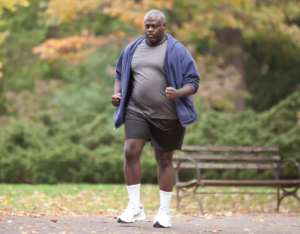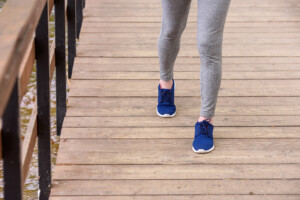If you have osteoarthritis of the knees, does this mean fast walking is off-limits? Must you confine yourself to turtle walking until you get a knee replacement?
Researchers from the Northwestern University Feinberg School of Medicine in Chicago wanted to find out if it was safe, or even beneficial, for people with knee osteoarthritis to briskly walk for a sustained period of time.
How the Study Was Done
• Data from over 1,500 senior adults was analyzed. Their medical data had been part of the national Osteoarthritis Initiative.
• The participants wore accelerometers to monitor activity over a four year period.
• What’s important is that none of the subjects had pain, aches or stiffness at the start of the study.
Would there be a difference in activity level among those who eventually developed pain and stiffness at the end of the study, compared to those who still remained symptom-free?
After analyzing the results, the researchers found that one hour – a week – of “moderate to vigorous” activity was safe and helped prevent debilitating pain and stiffness.
An accumulation of one hour a week of brisk exercise lowered the risk of mobility impairment by 85%.
The researchers considered swift walking to be moderate to vigorous. An accelerometer will surely record brisk walking.
At the study’s conclusion (American Journal of Preventive Medicine, May 2019, Dunlop et al), 24% of the participants, whose accelerometers recorded LESS than an hour a week of brisk walking, were not able to walk across a street fast enough to beat the light change!
Slow walking is what’s not ideal for this population.
And 23% reported they had difficulty with regular morning tasks.
When to Incorporate an Hour’s Worth of Brisk Walking into Every Week
It need not be done all at once. Ten minutes a day will do the trick.
• Every chance you get, walk at a fast pace. This includes from your car to the convenience store and back; down store aisles unless you’re searching for something in that particular aisle; to and from the mail box; down corridors at work; inside other buildings as well; and even around your house.

• If you’ve been walking a dog, pick up the pace, even if it’s a small dog. Fast walking is good for dogs, too.
How to Walk Faster
There are two ways this can be done, says Dr. Damien Howell, a physical therapist with Damien Howell Physical Therapy.
“A faster velocity occurs as a result of both increasing step length and increasing step frequency,” says Dr. Howell.
“If the individual preferred habit of walking is to take proportionally longer steps rather than proportionally more steps per minute, it can result in increased impact loading or increase in ground reaction forces into the leg and osteoarthritic knee or hip joint.
“It is safer to walk briskly if steps per minute (cadence) for walking is equal to or greater than 120 steps/minute.”
• If you have access to a treadmill, walk briskly on it for 10 minutes every day, or maybe 15 minutes four times a week – or whatever permutation works best for you.

Shutterstock/gpointstudio
Damien Howell, PT, DPT, OCS, specializes in orthopedic musculoskeletal problems, motion analysis, gait training, education on treatment/prevention of movement system disorders and wellness, and more. He provides home visits.
 Lorra Garrick is a former personal trainer certified by the American Council on Exercise. At Bally Total Fitness she trained clients of all ages for fat loss, muscle building, fitness and improved health.
Lorra Garrick is a former personal trainer certified by the American Council on Exercise. At Bally Total Fitness she trained clients of all ages for fat loss, muscle building, fitness and improved health.
.



























